
After a continental breakfast and another stop at Safeway for snacks, I drove the six miles to Joseph, Oregon where I found the grain elevator with the train parked waiting for us all to arrive for the first of the rare mileage trips.

I parked and met with Bart Jennings, our trip's organizer, then acquired the consist. Wallowa Union Railroad Authority GP35 4508, ex. Idaho and Northern Pacific 4508, exx. Wheeling and Lake Erie 2657, exxx. Norfolk Southern 2657, nee Southern 2657 built by Electro-Motive Division in 1965; baggage car 6741, nee Southern Pacific 6741 built by Pacific Car and Foundry in 1962; table car 1946, ex. New Jersey Transit 5309, nee Great Northern 56-seat coach 1120 built by Pullman-Standard in 1947; chair car 3241, ex. coach 1945, exx. New Jersey Transit 2408, nee Santa Fe 3241 built by Budd Company in 1938; coach 2636, nee Illinois Central 2636 built by Pullman-Standard in 1947.
All of the cars were later owned by Robert R. McClanahan, former Cotton Belt/Southern Pacific Superintendent, who purchased 1120 and 3241 in December 1989, the 6741 in 1993 and the 2636 in 1997. These cars operated with Cotton Belt 819 excursions and were also leased to various tourist operations before being sold to the Idaho Northern and Pacific Railroad in 1998, then were sold and moved to the Joseph Branch in 2003.
Our train is named after the Eagle Cap Wilderness Area in the Wallowa Mountains, which are over 10,000 feet high featuring glaciers and wild rivers.
I settled into the former Santa Fe car then bought this year's T-shirt featuring this set of rare mileage trips.
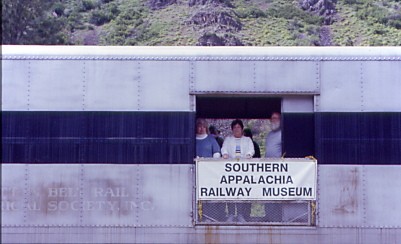
The banner of our trip's sponsor.
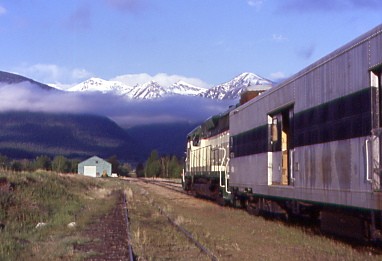
The former Union Pacific Joseph Branch is one of those lines that somehow falls into the category of a legend. Maybe it is because it was built in an area of enormous beauty but where few actually travelled. Maybe it was because the line seemed to just stick out on the maps, being surrounded by a large area of whiteness. Whatever the reason, the line has an interesting history.
The line was originally built up the Grande Ronde Valley between La Grande and Elgin in 1890 by the Oregon Railway Extension Company. This initial line provided service to the large farming industry throughout the valley and also connected the valley to the timber industry at Elgin. North of here, the country got very rugged and its was not until fifteen years later that the line was extended. By the early 1900's, most of the railroads in the northwest were being acquired by the consolidating systems of Northern Pacific, Great Northern and Union Pacific. The Oregon Railway Extension Company was no different as it had been acquired by the Oregon Railroad and Navigation Company, a Union Pacific subsidiary (originally built by Henry Villard as the Oregon Railway & Navigation Company). With this acquisition and its accompanying financial power, the line was extended on to Joseph between 1905 and 1908 by the Oregon Railroad and Navigation Company. The completion of the line to Wallowa was celebrated with an excursion train from La Grande to Wallowa in 1908. Between 1,500 and 2,000 people gathered with much fanfare, including several brass bands, to celebrate the arrival of the first passenger train. Ticket prices for the first train to Wallowa were $1.75. The line reached its maximum length in 1927 when the line was extended a short distance in Joseph to reach a new grain elevator.
Between World Wra I and the Great Depression, the Joseph Branch was usd extensively for hauling logs to local saw mills. During the booming 1920's, a dedicated daily passenger train served the line with a planned and advertised direct connection to and from Portland, Oregon. A depression and World War II changed this somewhat, as did the development of the personal automobile and a system of roads. By 1948, the Joseph Branch was part of the Idaho Division, which extended all the way west to La Grande. A daily except Sunday mixed train served the line as Train 304 eastward (towards Joseph) and Train 305 westward. It made a full found trip each day it ran, leaving La Grande at 7:00 AM and arrriving at Joseph at 11:15 AM. It left Joseph at 12:45 PM and got back to La Grande at 5:00 PM, both trains taking four hours and fifteen minutes for an average speed of 19.7 miles an hour. The departure and arrival times at La Grande were convenient for locals but they meant a several hour wait after getting off Train 18 at 4:57 AM or for Train 17 and 9:00 for movements from and to Portland. Eastbound connections were really bad, generally with a six hour wait.
By August 1949, the Joseph Branch was part of the Oregon Division. Mixed train service over the branch continued through the April 24, 1960 public timetable, always found in Table 72 of the Union Pacific public timetable. The final schedule showed the train operating s Trian 304 to Joseph daily except Saturday with the return Trian 305 operating daily except Sunday. The two trains operated separately (not as a daily round trip as done earlier) with them meeting somewhere betwen Elgin and Looking Glass. Actually, the trains probably met at Elgin with Gulling being used as an alternative siding. Since both trains operated as mixed trains and a great deal of business existed at Elgin, the rider probably had some time to see the sights while waiting at Elgin for the La-Grande bound train to do its work.
During steam days, the Joseph Branch was limited to consolidation-type locomotives. As diesel-electric locomotives took over, early GP-type locomotives generally handled the trains. Business on this line has always included two major items: lumber and grain. Sawmills has been located all along the line, primarily at La Grande, Elgin, Wallowa, Entreprise and Joseph. Grain elevators stand in almost every town, today generally labelled PGG (Pendletown Grain Growers) or Wallowa County Grain Growers. While most of the grain up here is wheat, other crops such as mint and grass seed are common. Livestock was also once a product moved over the line in some volume, as evidenced by the number of abandoned corrals along the railroad.
During 1985-1986, your trip coordinator was Roadmaster for Union Pacific in La Grande. His territory included the Joseph Branch, as well as the mainline to Huntington. In late February 1986, a series of fast thaws and freezes caused a great deal of flooding along the line. Notes from the time show 15 specific locations where the track was either washed out, under water or covered with a mudslide. It was such a big job that we actually got a special repair budget and it took several weeks to have the line all put back together.
In 1993, Union Pacific sold the Joseph Branch to the Idaho Northern and Pacific as part of a package of rail lines in the area. To protect the part of the line with the greatest concentration of business, Union Pacific maintained the ownership of the right-of-way between La Grande and Elgin, preventing passenger service over this part of the line. By March 1996, freight service to Joseph stopped. Abandonment of the line above Elgin was approved in April 1997. After several years of public debate, the Oregon Legislature earmarked $2 million for the purchase of the line and to start its rehabilitation. On March 31, 2002, the purchase of the line between Elgin and Joseph cleared escrow with an initial plan to reopen the line between Elgin and Wallowa. To operate the line, the Wallowa Union Railroad Authority was formed immediately afterward and assumed operation of the line on May 31, 2003. The first train back into Joseph finally operated during November 2003. The Wallowa Union Railroad Authority originally contracted with the Idaho Northern and Pacific to operate the line above Elgin as required by the on-line customers. However, beginning on December 19, 20023, Wallowa Union Railroad crews started doing the work.
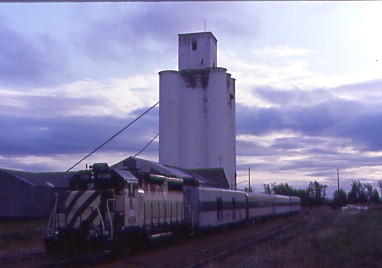
Our trip originated under the Wallowa Grain Growers elevator which sits in the middle of the wye. At 8:00 AM, we started our journey into the Enterprise Valley by proceeding west to cross the Wallowa River for the first of many crossing before turning north.

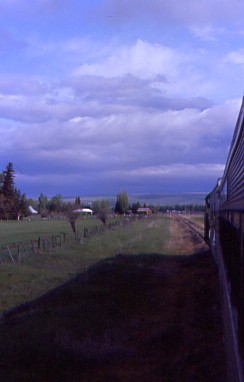
The train crossing the Enterprise Valley. Here we spotted the first animals of the day, a herd of deer running away from the train. The Wallowa Mountains were shrouded in clouds as we passed the remains of the Joseph Forest Product mill. It was a chilly morning as I was riding the vestibule, where I stayed for most of the time. Off to the west was Joseph Airport as we proceeded north across the valley.
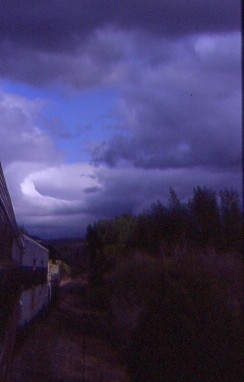
Some impressive clouds. We crossed an irrigation canal at MP 81 before crossing the spread-out Wallowa River on three separate trestles as the river has a very wide path at this point. After turning to the west, we made our way into Enterprise which has a grain elevator.
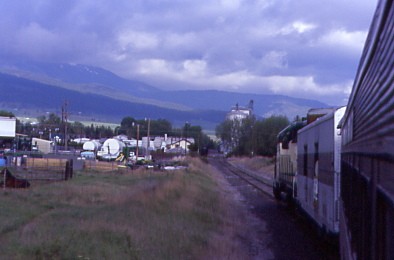
West of Enterprise, the Wallowa River was again crossed using only two bridges this time. Next at MP 76.79, we crossed Hurricane Creek before traversing Wallowa River again, this time on a single bridge at MP 75.22 then entered a short canyon before passing the former siding location of Freel, MP 75.17. At MP 72.62, it took two bridges for our next crossings of the Wallowa River.
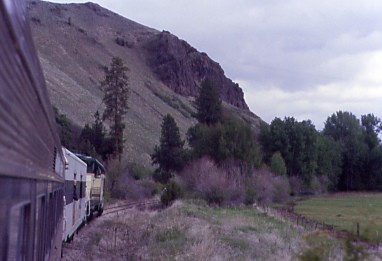
Next we rolled to the north of Lostine, MP 67.45, and further Wades Point, a rocky point, sticks out into the valley to the south. Over on Highway 8, Evans was seen before another crossing of the Wallowa River, this time on three bridges as the river has spread out over a third of a mile. Beaver Creek was next crossed at MP 64.74, followed three miles later by our crossing of Whiskey Creek as we rolled down this valley.
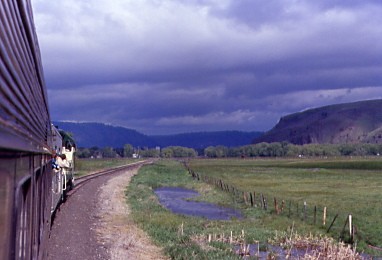
At MP 57.56, we bridged the Wallowa River once more, followed shortly by Mill Ditch at MP 59.66 before we rolled into Wallowa with its grain elevator for a photo stop while the engine was watered.
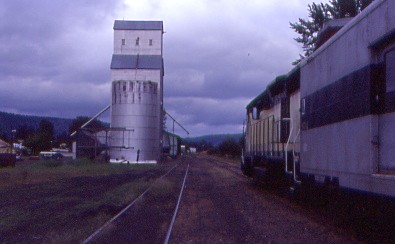
Wallowa, Oregon at MP 59.53. Originally called Gate City, the first post office in Wallowa County opened here in 1873. However, the post office was not actually in Wallowa, but was at the bridge over Whiskey Creek east of here. Wallowa was named for (1) the valley, (2) the mountains or (3) the river, depending upon which source you believe. A "wallowa" is part of a willow fish trap used by local Natives, an indication of the good fishing found in the area streams. Wallowa was the site of the first large-scale timber mill in the county.

Leaving Wallowa we passed the wye where another GP35 rested between jobs. I learned that the GP35s here were numbered as the railroad was about to trade them for three GP9s. West of town, we crossed Bear Creek at MP 58.86 then passed the main revenue producer on the railroad with its own gasoline switcher.
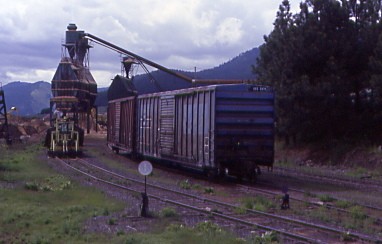
The lumber mill at Sevier at MP 56.27. From here, we entered the beautiful Wallowa River Canyon with outstanding vistas to behold on the east wall.
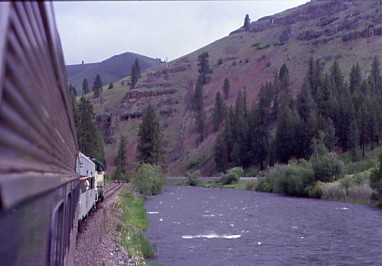
The train passed through a shower as some passengers were on animal alert hoping to spot big horn sheep, elk or even a bear along our route or on the canyon walls. As the train wound through the canyon, we passed beneath Minam Point before crossing the Wallowa River one last time on a deck bridge at MP 46.90. We now had reached Minam where the tracks crossed Highway 82 and the Minam River joined the Wallowa River Canyon from the west.
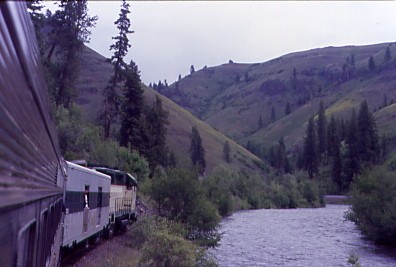
About the leave the roads behind as we entered the Minam State Recreation Area. About a mile later, we passed a campground across the Wallowa River where a young boy was waving his heart out at our train. From here on, it would be the train and the few whitewater rafters on the river through the rest of the canyon.
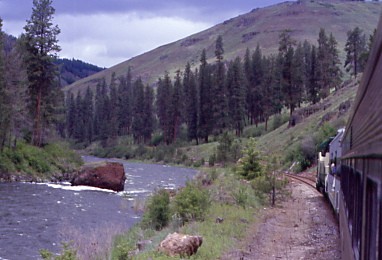
The train crossed Fisher Creek at MP 42.33 as we continued to curve through the canyon then rolled by the retired station at Vincent, MP 40.6, before crossing Howard Creek at MP 40.28. We continued to curve along the river to Kimmell with its 3,940 foot passing siding. Two miles later, we passed Rondowa, a made-up name meaning the junction of the Grande Ronde and Wallowa Rivers.
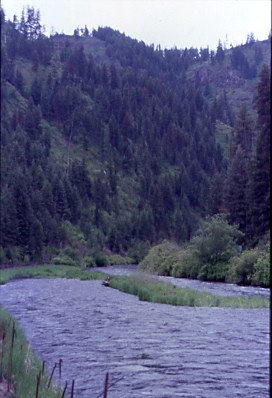
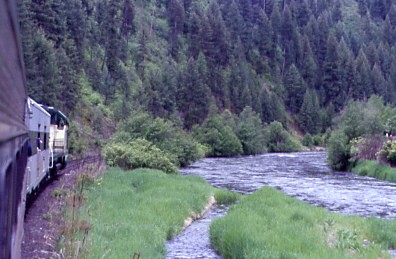
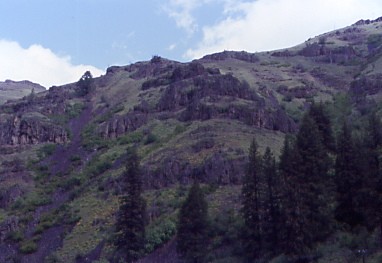
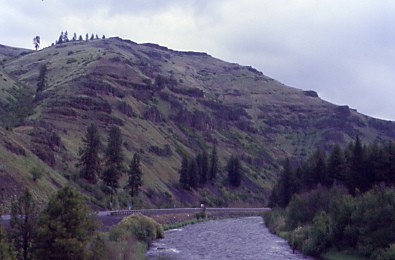
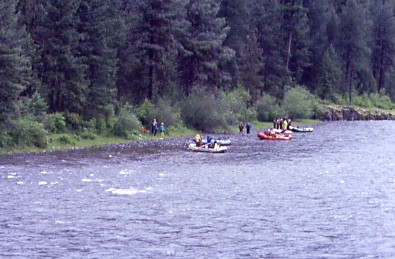

Rafters enjoy the passing of our train. Now we travelled along the Grande Ronde River.
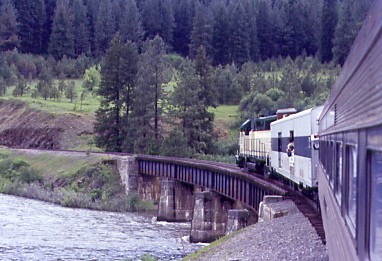


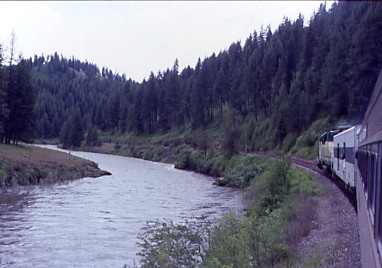
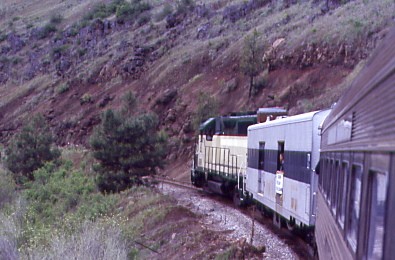
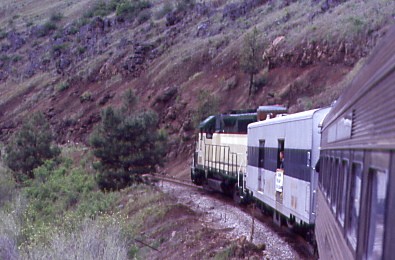
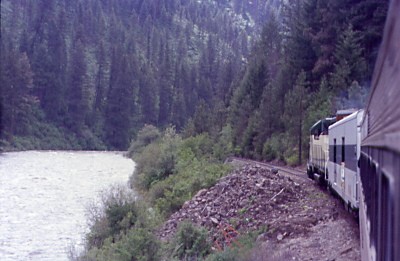
We crossed the Grande Ronde River at MP 36.85 on a four-deck plate girder bridge and turned back southeast now following that river. Three curving miles later, we passed through Looking Glass before crossing the creek of the same name at MP 33.13. At MP 32.55, we crossed Schotte Creek then had a grade crossing with Yarrington Road with the truss bridge across the river. A little while later, at MP 30.85, we bridged Cabin Creek before passing the site of the former Cabin Creek siding and then Mill Creek was crossed. Three miles further, we crossed Partridge Creek at MP 26.51 before we rounded a pair of 16 percent curves with the wheels screeching at MP 27.1 and 26.0. That brought our train to the 1,650 foot siding of Gulling, the westward end of our trip today.

At Gulling, we were allowed off as the engine ran around the train. We discovered some 1888 and 1889 rail made by the Joliet Rail Company in the siding.

Wallowa Valley Union Railroad GP35 4508. There was some disappointment among our group that we did not run the rest of the way into Elgin, but I was glad to have come this far.

Passing the rock in the Wallowa River on the way back to Joseph with the GP35 running long hood forward. I worked on the story for a while until it was announced that we would do a photo runby at the Grande Ronde bridge and some of us detrained in the rain.

As the train reversed onto the bridge for a static picture, it started to rain harder.

The passengers who had stayed aboard stared at all of us as we returned, being amazed by the conditions the photographers were in. I managed to keep my camera dry during that exercise. We continued up the Wallowa River Canyon as the rain stopped and the sunshine returned then stopped at the Highway 82 crossing to drop off the caterers.
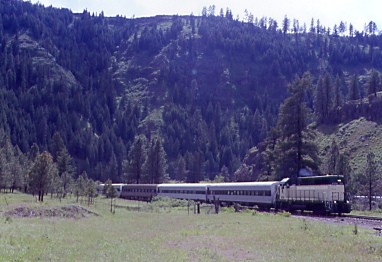
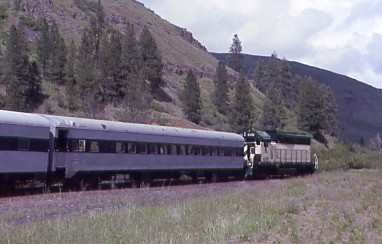
We made our last photo runby of the day at MP 48 and this one was done under sunny skies.

The Wallowa River.
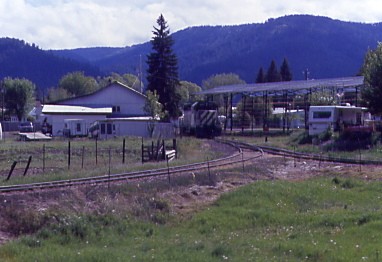
The Wallowa wye with another GP35.
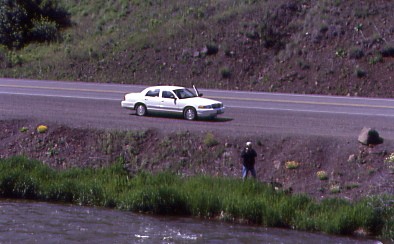
Joe Harper, whom I met at Safeway this morning, was going to photograph the train today and then ride the extra trip tomorrow.
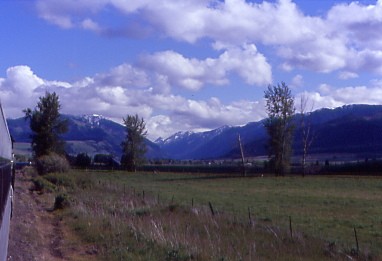
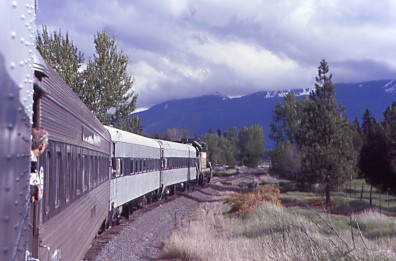
More views of the journey back.
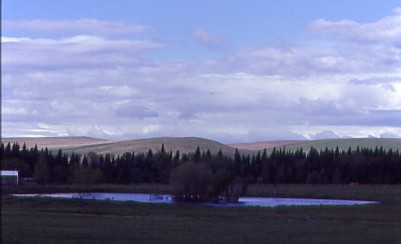
Rolling through the Enterprise Valley.
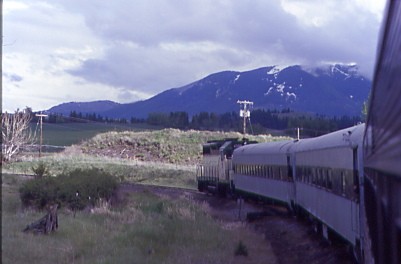
The last curve into Joseph.
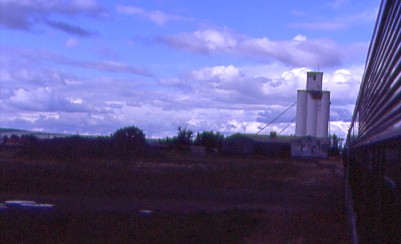
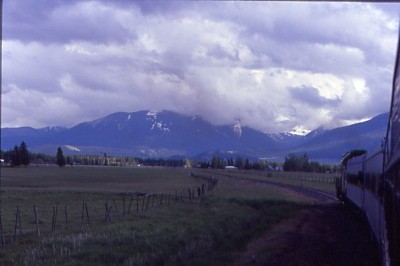
Arriving at Joseph.
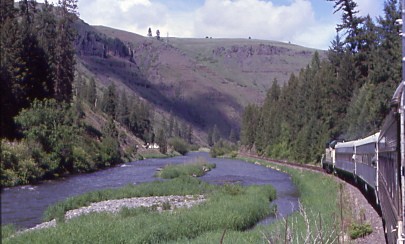
It had been a really fun day of railroading as arrived at 5:40 PM ending an exciting trip on the Eagle Cap Limited.
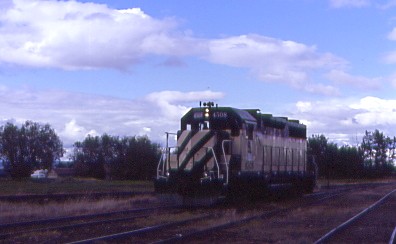
Running around the train to be ready for the second trip on Sunday. I drove back to Enterprise and had dinner at the Plush West Restaurant having a rib steak served by Kayla.
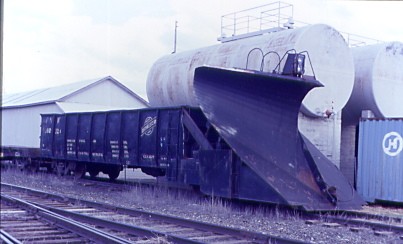
The former Chicago and North Western snow plough before I filled the car and returned to the hotel for a good night's rest.
| RETURN TO THE MAIN PAGE |